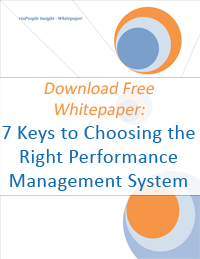5 Ways to Take the 'Creep' Out of Employee Performance Ratings
One of the countless complaints about performance reviews is that performance ratings are inaccurate. Whether an organization is using a traditional 5 point rating scale to evaluate performance criteria or a non-numeric determination of overall performance, the general trend is for the distribution of ratings to be positively skewed versus represent a normal bell curve.

Dangers of Performance Rating 'Creep'
Inaccurate ratings can negatively impact the credibility of the employee performance management process, hinder performance and drive away high performers. When ratings trend up, differentiating between high and low performers becomes almost impossible, and in turn, true high performers are not rewarded. Development opportunities are not provided to those in need as ratings do not indicate that improvement is needed so plans are not put in place and coaching is not done. Organizational performance suffers as individuals are not motivated to improve when they believe that they are already demonstrating high performance. Lastly, inaccurate ratings can be the source of potential legal action.
What Pushes Performance Review Ratings Up?
Given the tools that are available to support effective performance evaluation, why is it that managers still struggle with evaluating performance? There seem to be several reasons why performance ratings tend to ‘creep.’
- Organizational Culture. Many organizations demonstrate positivist values, sending a message that all employees are high performers.
- Fear of Conflict. Managers may provide high performance ratings to avoid having a negative discussion with employees.
- Lack of Skill. Managers often lack the skills in observing and accurately evaluating performance.
- Performance Expectations and Rating Scales are Not Clearly Defined. Without clear definitions of expected performance and rating scale options managers are left to use their own definitions.
- Expectation of Continuous Improvement. Some employees and/or mangers believe that ratings should improve each year. As such, a rating of "Good" becomes "Excellent" the next year without actual performance improvement.
- Common Rater Biases. Accuracy of ratings may be impacted by common rater biases or errors including the halo effect, leniency bias, and straight ticket error. These unintentional pitfalls may cause inaccurate performance ratings.
- Overemphasis on Performance Ratings. Performance ratings are often seen as the most important part of the employee performance management process when they are only one small piece of the process.
Correcting the Curve
 While the list of potential reasons for positively skewed performance ratings may seem a bit daunting, the answer is NOT to abandon performance reviews or institute forced ranking to fix the problems. We have outlined 5 ways that company's can correct the curve and ultimately, enhance the effectiveness of the performance management process.
While the list of potential reasons for positively skewed performance ratings may seem a bit daunting, the answer is NOT to abandon performance reviews or institute forced ranking to fix the problems. We have outlined 5 ways that company's can correct the curve and ultimately, enhance the effectiveness of the performance management process.
- Manager Training.The accuracy of performance ratings can be improved by providing training to managers and setting the stage for accurate ratings at the start of the performance management process. Training should include goal setting, providing feedback and coaching, as well as how to make fair and accurate performance ratings.
- Include Multi-Rater or 360 Degree Feedback. Given the complexity of work and organizational structures today, most managers are unable to observe all aspects of employee performance. Integrating 360 degree feedback, peer review or upward feedback can provide managers with rich information upon which to make accurate performance ratings. Click here to download our recent eBook: Are You Ready for 360 Feedback? A 5 Point Guide to Assessing Your Company's Readiness.
- Ongoing Feedback and Check Points. The performance management process should include goal setting with clearly defined targeted results and encourage frequent documentation of progress along the way. Ongoing communication and documentation will provide managers with additional insight into performance, strengths and development needs throughout the year. Manager tips for improving the frequency of ongoing feedback can be found in this article: Dread Performance Appraisals? Easy Does It With Ongoing Feedback and Coaching.
- Implement Performance Calibration. The collective discussion that occurs regarding performance during the performance calibration process allows managers to have new insight into the performance of employees and reduce potential bias. Peer-to-peer discussion brings about transparency - calling attention to an individual manager's tendency to rate leniently or harshly. As a result, the accuracy of performance ratings is increased. Learn how to implement performance calibration in your company by reading our eGuide: A Practical Guide to Performance Calibration.
- Use Technology. viaPeople's performance management software offers organizations the ability to easily manage the performance management process and gain rich insight into the patterns of ratings across the organization.
Share this
You May Also Like
These Related Stories

Calibrate, Don't Force in Employee Performance Management

3 Expert Tricks to Identify Poor Performance Calibration



